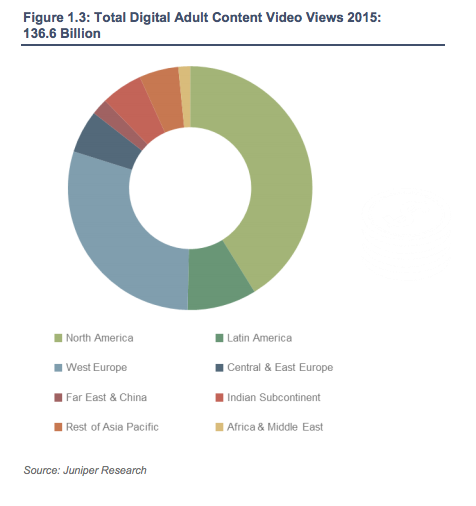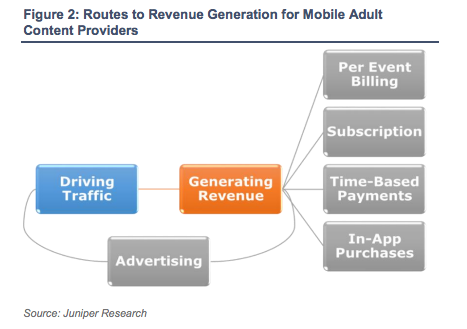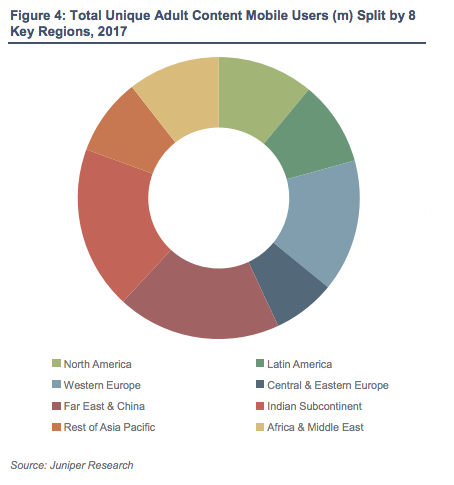
Never has the term “money shot” been more applicable than to where digital porn is heading.
A new study from U.K.-based research firm Juniper Research found that the adult video industry is increasingly feeling the pinch from an attention deficit that has more viewers looking for “snackable” pieces of porn rather than the full deal.
Lauren Foye, a Juniper analyst who wrote the report, said that people are increasingly fast-forwarding to what she called the “highlights” rather than watching the whole video — a trend that should have porn producers creating shorter snippets of content, just like in the mainstream video world. “People are now watching snippets rather than the whole video,” Foye told Digiday.
But in pure numbers, the porn world is still huge — and poised to get bigger. The firm found that 136 billion adult videos will be watched in 2015. By 2020, this number is set to grow to a whopping 193 billion, a 55 percent growth. The research found that there is a marked increase in porn-watching in developing markets, but the net growth is still greatest in the U.S.

While monetization is a concern for adult video sites, the industry has taken cues from other categories, like games, to find alternate revenue streams. Juniper found that “in-app purchases” and subscription services for webcams are on the rise. The figure below shows the different ways porn sites make money — per-event billing is slowing down, while subscription and in-app purchases are on the rise.

The growth in mobile video use is also notable. Juniper Research found that, globally, people who watch adult content on their phones will see an average of 348 videos this year — which may explain to some horrified New Yorkers why they seem to see more dudes watching smut on the subway than ever before.
One factor driving the boom is better video quality: “Larger screens on mobile devices are making it more convenient to access these videos,” said Foye. Over half — 51 percent — of adult video views will take place on mobile this year, up for 48 percent last year. Mobile adult subscriptions will reach nearly $1 billion this year; while mobile adult content and services overall will hit $2.8 billion.
 But porn is under pressure as well. Leading adult sites like PornHub and Redtube have struggled to maintain traffic and revenues. Here is where the popular adult websites rank among all sites on the Web in 2013 and 2015 — all of them have decreased in rank, mostly because consumers are increasingly seeking out free content from pirated downloads or “tube” sites. (Nielsen does not measure traffic on porn sites.)
But porn is under pressure as well. Leading adult sites like PornHub and Redtube have struggled to maintain traffic and revenues. Here is where the popular adult websites rank among all sites on the Web in 2013 and 2015 — all of them have decreased in rank, mostly because consumers are increasingly seeking out free content from pirated downloads or “tube” sites. (Nielsen does not measure traffic on porn sites.)
While porn “goes across all demographics,” according to founder of Adult Video News Paul Fishbein, research from Forrester has found some consistencies among who is actually watching all the smut that’s out there: 70 percent of porn-watchers are male, with men 543 percent more likely to look at porn than women. Those who say they are “happily married” are 61 percent less likely to look at porn, according to a U.K.-based General Social survey.
More in Media

Meta AI rolls out several enhancements across apps and websites with its newest Llama 3
Meta AI, which first debuted in September, also got a number of updates including ways to search for real-time information through integrations with Google and Bing.

Walmart rolls out a self-serve, supplier-driven insights connector
The retail giant paired its insights unit Luminate with Walmart Connect to help suppliers optimize for customer consumption, just in time for the holidays, explained the company’s CRO Seth Dallaire.

Research Briefing: BuzzFeed pivots business to AI media and tech as publishers increase use of AI
In this week’s Digiday+ Research Briefing, we examine BuzzFeed’s plans to pivot the business to an AI-driven tech and media company, how marketers’ use of X and ad spending has dropped dramatically, and how agency executives are fed up with Meta’s ad platform bugs and overcharges, as seen in recent data from Digiday+ Research.





